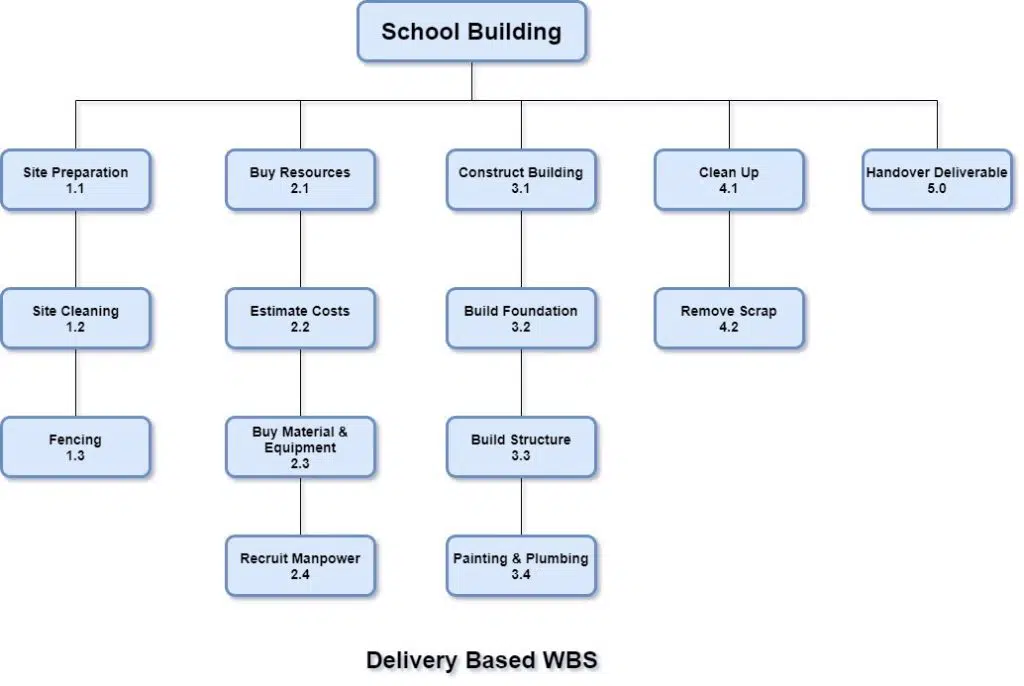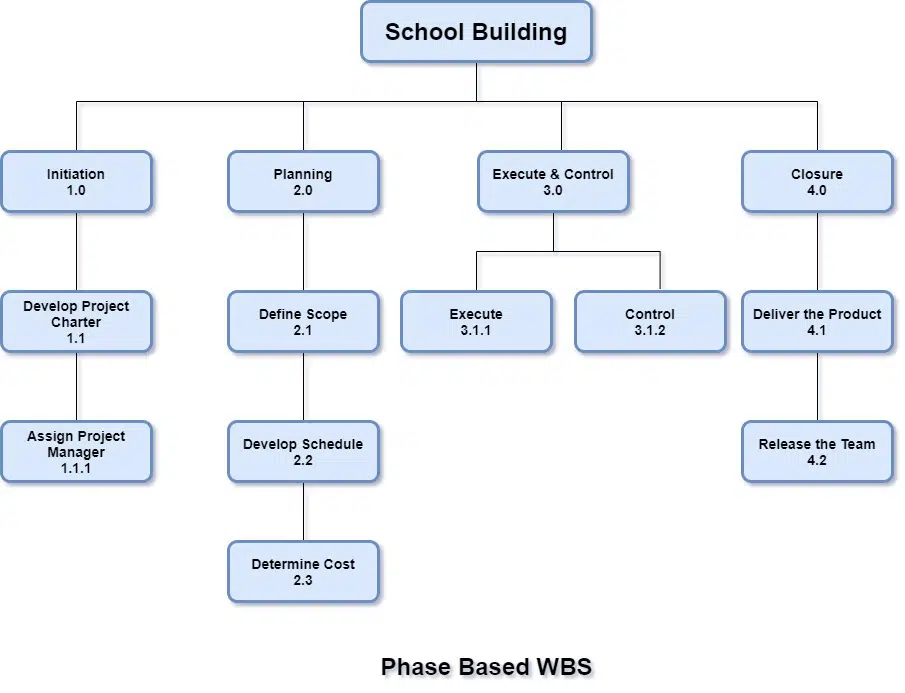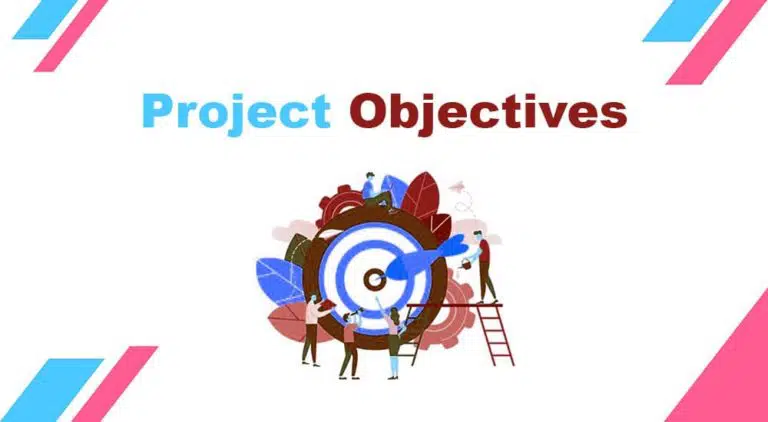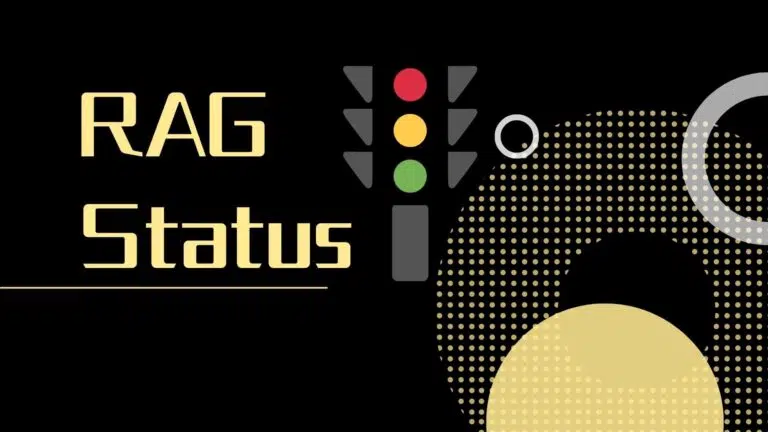Work Breakdown Structure (WBS) is an important project management document that helps you clarify the scope of work and assist in project planning.
It is one of three components of the scope baseline. The other two elements of the scope baseline are the scope statement and WBS Dictionary.
If you are into project management, a better understanding of the Work Breakdown Structure will help you develop a robust plan and project network diagram, and you will be able to complete the project with less hassle.
Work Breakdown Structure
Definition: As per the PMBOK Guide, a Work Breakdown Structure is a “deliverable oriented hierarchical decomposition of the work to be executed by the project team.”
A Work Breakdown Structure is a visual, hierarchical breakdown of a project into smaller components.
It is the basis of your project planning and helps you identify all project components to find the project cost and develop the schedule accurately. It integrates project scope, schedule, and cost baseline and ensures that all project plans are aligned.
A Work Breakdown Structure can have two to three levels; however, complex projects can have more levels as required.
Types of Work Breakdown Structure
The following two types of WBS are most popular in project management:
- Deliverable-Based WBS
- Phase-Based WBS
Deliverable-Based Work Breakdown Structure
A deliverable-based WBS breaks down the project based on deliverables, such as products, services, or results.
An example of a deliverable-based WBS is given below:

Phase-Based Work Breakdown Structure
Many times, you break projects into phases for better management. In such cases, the Work Breakdown Structure will be based on phases.
Here, the final deliverable stays at the top, and the lower level shows five project management phases: initiation, planning, execution, monitor and control, and closure.
An example of phase-based WBS is given below:

Apart from these two types of WBS, you may also find the following uncommon WBS:
Noun Oriented WBS: This is also known as product breakdown structure and breaks up the project in terms of a product component.
Verb Oriented WBS: This task-oriented WBS defines deliverables in terms of actions taken to develop the deliverable.
Time Phased WBS: This WBS structure is used for projects with a longer duration. Here, you break the project into phases and adopt a rolling wave approach that helps develop plans for the near-term phase in detail.
A few other less common WBS are:
- Geographical Type
- Cost Breakdown
- Profit Center Type
Elements of Work Breakdown Structure
A WBS consists of the following:
- Work Packages
- Planning Packages
- Control Accounts
Work Packages: These are the lowest level elements of each branch of the WBS. Work packages include details about the deliverable’s owner, the durations, milestones, resources, risks, etc.
Planning Packages: A planning package is different from a work package. After the project management plan is approved, its scope is defined, and the Planning Packages provide the complete scope. With these details, planning packages turn into work packages.
Control Accounts: Control Accounts let you collect, analyze, and report data for elements inside the Work Breakdown Structure to aid in reporting and monitoring.
All WBS elements must have the following four items:
- The scope of work, including deliverables.
- The starting and ending dates and the duration.
- The budget.
- The name of the person responsible.
How to Develop a Work Breakdown Structure
A Work Breakdown Structure includes the complete project work. Developing a WBS is an iterative process; you repeat it when new information is available or the scope changes.
The following are key steps required in developing the Work Breakdown Structure:
#1. Collect All Information and Data
You must understand the scope of work and project stakeholders’ requirements. This is a vital step; here, you will refer to the project charter, contract documents, project plan, etc.
Ensure you collect all project data and information because your WBS will be incomplete if you miss any information.
#2. Define the Type of WBS, Levels, and Elements
After clarifying the scope of work, decide the type of WBS you will create and then identify the major deliverables of your project.
Define the WBS levels. WBS has two or three levels, but larger projects can have more levels depending on the requirements.
Ensure you capture 100% of the scope; each level must cover the complete scope of work.
#3. Decompose the WBS Elements
Determine the work package which is the lowest in the hierarchy of your WBS. The work package must be definable, independent, estimable, manageable, integratable, and measurable. Use nouns or adjectives to describe each work package.
Decide if the WBS will be deliverable-based or phase-based.
Decompose the project scope into a level 1 deliverable. Ensure all WBS elements are unique. Afterward, decompose the level 1 elements into level 2 and level 3, ensuring all sub-elements are unique and have a unique identifier.
Stop when you think you cannot go any further. The elements in the lowest level of the WBS are known as work packages.
Now you have your Work Breakdown Structure.
There should not be an overlap in the scope of two different WBS elements at the same level. If there is some ambiguity in names, you must clarify this in the WBS Dictionary.
#4. Create WBS Dictionary
A WBS is incomplete without a WBS Dictionary.
You should create a WBS dictionary along with the WBS as it outlines and defines the scope of each WBS element. It helps you understand the project team and the work package better.
A WBS dictionary can have the following details: work package name, risk, assumptions and constraints, work package ID, work package description, name of the assigned team member, estimated cost, duration, due date, etc.
#5. Develop Project Schedule
You will break down work packages into activities and develop schedules to develop your project schedule. The schedule can be based on a Gantt chart or network diagrams, such as the critical path method, PERT, or critical chain method.
100% Rule in WBS
This is the most important WBS principle and says WBS must include 100% of the project work and capture all internal, external, and interim deliverables. This rule applies to all levels of WBS, meaning the sum of the work at the lower level must equal 100% of the work represented by the upper level.
This rule applies to an activity level as well. The work represented by activities in a work package must be equal to the work represented by the work package.
Uses of Work Breakdown Structure
A WBS breaks down the project scope into manageable components to make it easier to plan, manage, and deliver.
WBS is very helpful in project management. It is a planning tool and clarifies the scope of work. It helps you find project costs, develop schedules, and monitor and control project work.
Importance of Work Breakdown Structure
WBS has great importance in project management. It clarifies the scope of work; you can easily identify all project activities, see the dependencies among the project tasks, avoid duplicate work, determine task duration, and calculate the budget for each work package.
A sound Work Breakdown Structure helps you avoid many issues, such as scope creep, gold plating, cost overrun, and schedule delays.
A WBS provides you with complete control over your project.
Advantages of Work Breakdown Structure
WBS has many benefits in project management:
- WBS is the basis of your scheduled cost estimation. You will know all project deliverables and project management dependencies.
- Since all work packages in WBS are independent, you can assign each work package to different team members. This increases responsibility and accountability.
- You will avoid duplication of tasks and scope creep as it clarifies the scope of work. There will be fewer disputes, and workflow will be smooth.
Disadvantages of Work Breakdown Structure
Though WBS has many advantages, it also has some disadvantages.
- Some people may find it difficult to develop a hierarchical-based Work Breakdown Structure, which is an additional task for them.
- Developing WBS requires experience and time. If team members are not experienced and skillful, the WBS may ignore some scope of work.
- To develop a WBS, you must have a complete and detailed scope of work. In many cases, you don’t have these details at the beginning of the project, so developing the WBS is not easy.
- If WBS is not well controlled for larger projects, the scope of work can be duplicated.
- After developing the project schedule, the emphasis shifts to schedule, and WBS is often not updated.
Work Breakdown Structure Best Practices
- Ensure that each level of WBS represents 100% of the scope of work. This rule is known as the 100% rule. All work at the child level must be equal to 100% of the work at the parent level.
- Ensure that all elements in WBS are mutually exclusive. No two elements should share any scope of work.
- Don’t go too deep. Usually, two to three decomposition levels are enough, and for larger projects, it can be more than that. However, if you go deeper, it will be complex and confusing.
Work Breakdown Structure Example
A WBS can be in any form. It is not necessarily just in chart form; it can be in graphical, Excel, and tabular view. You can select the WBS based on your project requirements.
Some examples of Work Breakdown Structure are given below.
WBS Flowchart: This is the most common WBS example. Here you draw a hierarchical chart of WBS.
WBS Excel Sheet: Here, you design your WBS in a spreadsheet using columns and rows.
WBS Gantt Chart: This is another commonly used WBS structure.
WBS List: Here, you make a list of your WBS element in a Word file. This WBS structure is easy to create.
Characteristics of a Work Breakdown Structure
A WBS has the following characteristics:
- It is a delivery or phase-based hierarchical structure of the complete scope of work.
- It contains 100% of the scope of work.
- It communicates the scope of work to project stakeholders.
- It can be graphical, tabular, or in a list form.
- It has at least two levels of detail.
- It is a numbering system used to identify elements and work packages.
Work Breakdown Structure Vs Project Schedule
Many beginners confuse WBS with project schedules. Note that both are different and serve different purposes.
A Work Breakdown Structure clarifies the scope and provides you with the “what” part of the project. You will know exactly what you need to complete to finish the project.
On the other hand, the project schedule will provide you with detailed activities you need to carry out to complete the project. You can see all activities, their duration, milestones, critical path, etc.
WBS is the basis of the project schedule as it provides work packages. In these work packages, you find project activities, resources, duration, and relationships. Build a network diagram, and then develop the project schedule.
Summary
A Work Breakdown Structure is one of the first documents you create after making the project charter. After creating the WBS, you develop your project schedule.
WBS helps develop schedules; it provides all work required to complete the project in an orderly format.
You can visualize the project work, estimate cost and duration, and assign resources. You can see the interdependencies among the project tasks.
This topic is important from a PMP exam point of view.

I am Mohammad Fahad Usmani, B.E. PMP, PMI-RMP. I have been blogging on project management topics since 2011. To date, thousands of professionals have passed the PMP exam using my resources.








Pls, do you have a sample 2 storey reinforced concrete building?